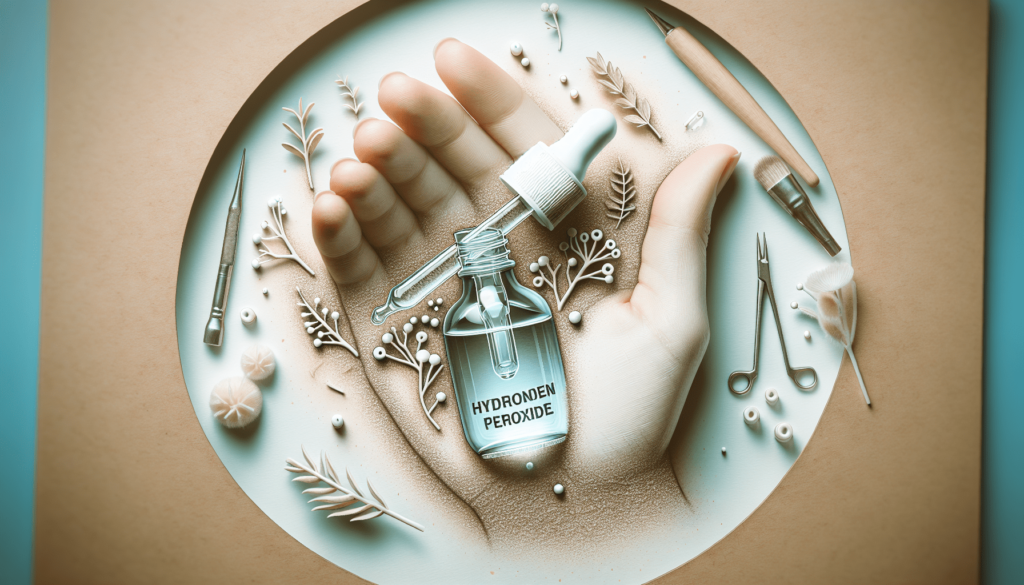Have you ever wondered about the impact of hydrogen peroxide on fungal infections, particularly those affecting your nails? If you’ve struggled with toenail fungus or similar conditions, you’re not alone! Many people are searching for effective remedies to restore their nails to a healthy state.

Introduction to Fungal Infections
Table of Contents
Fungal infections, especially of the toenails and fingernails, are more common than you might think. These infections can lead to discoloration, thickening, and even crumbling of the nails. It’s an unsightly and often painful condition that can make you self-conscious and uncomfortable.
Common Types of Fungal Infections
Different fungi can cause infections in various parts of the body, including:
- Athlete’s Foot (Tinea Pedis): This affects the feet, particularly between the toes.
- Ringworm (Tinea Corporis): Contrary to its name, ringworm is a fungal infection causing a circular rash, often itchy and red.
- Toenail Fungus (Onychomycosis): This is a specific type of fungal infection that affects the nails, causing them to thicken, color, and fragment.
Causes of Fungal Infections
Fungal infections often arise in warm, moist environments. Whether it’s due to wearing sweaty socks or not drying off properly after a shower, certain habits can make you more susceptible to these infections.
The Basics: What is Hydrogen Peroxide?
Hydrogen peroxide (H₂O₂) is a common antiseptic used in homes worldwide. It’s known for its bubbling fizz that appears upon contact with skin, which signifies its action against bacteria and fungi.
Chemical Properties of Hydrogen Peroxide
Hydrogen peroxide is a pale blue liquid that appears colorless in a dilute solution. It works as an oxidizer, disrupting the cellular structure of bacteria and fungi, making it an effective disinfectant.
| Property | Description |
|---|---|
| Chemical Formula | H₂O₂ |
| Appearance | Colorless liquid |
| Uses | Disinfectant, bleaching agent |
| Reaction | Bubbles upon contact with organic matter |
Uses in Everyday Life
Apart from treating infections, hydrogen peroxide is also used in bleaching teeth, cleaning surfaces, and even in some cosmetic applications. Its versatility makes it a staple in many households.
How Does Hydrogen Peroxide Affect Fungal Infections?
Hydrogen peroxide can be an effective treatment for fungal infections due to its strong oxidizing properties. When applied to the infected area, it breaks down into water and oxygen. This reaction helps kill the fungus and prevent further growth.
Mechanism of Action
When hydrogen peroxide is applied to a fungal infection, it releases oxygen. This oxygen can damage the cell walls of the fungus, leading to its destruction. Additionally, the bubbling action helps remove dirt and debris from the infected area, promoting a cleaner healing environment.
Application Methods
There are several ways to apply hydrogen peroxide to a fungal infection:
- Direct Application: You can apply hydrogen peroxide directly to the nail using a cotton ball or swab.
- Soaking: Soaking the infected area in a hydrogen peroxide solution for a few minutes daily can help treat the infection.
- Mixed Solutions: Combining hydrogen peroxide with other antifungal agents can enhance its effectiveness.
Best Practices for Using Hydrogen Peroxide on Fungal Infections
To get the best results from using hydrogen peroxide on fungal infections, it’s important to follow some best practices.
Prep Your Nails
Before applying hydrogen peroxide, ensure your nails are clean. Trim them short and remove any nail polish. This preparation allows the hydrogen peroxide to penetrate more effectively.
Consistency is Key
Don’t expect overnight results. Consistently applying hydrogen peroxide for several weeks is crucial for seeing improvement. Patience and persistence are essential.
Monitor Your Progress
Keep an eye on the infected area. If you notice any adverse reactions like excessive redness or pain, discontinue use and consult a healthcare professional.

Potential Side Effects of Using Hydrogen Peroxide
While hydrogen peroxide is generally safe, it can sometimes cause side effects.
Common Side Effects
- Skin Irritation: Some people may experience irritation or a burning sensation at the application site.
- Dryness: Frequent use can lead to dry skin around the treated area.
- Discoloration: Rarely, hydrogen peroxide may cause discoloration of the skin or nail.
When to Seek Medical Advice
If you experience severe discomfort, swelling, or any signs of an allergic reaction, stop using hydrogen peroxide and seek medical advice. It’s always better to err on the side of caution.
Alternatives to Hydrogen Peroxide for Treating Fungal Infections
While hydrogen peroxide is effective, other treatments can be more suitable depending on the severity of the infection.
Over-the-Counter Antifungal Treatments
There are various antifungal creams, ointments, and oral medications available. Some popular over-the-counter options include:
| Product Name | Form | Main Ingredient |
|---|---|---|
| Lamisil | Cream, Gel | Terbinafine |
| Lotrimin | Cream, Spray | Clotrimazole |
| Tinactin | Powder, Spray | Tolnaftate |
Home Remedies
In addition to hydrogen peroxide, several home remedies can help:
- Vinegar Soak: Vinegar’s acidic nature helps kill fungi. Soaking your feet in a vinegar-water solution can be beneficial.
- Tea Tree Oil: Known for its antifungal properties, tea tree oil can be applied directly to the infection.
- Garlic: Believe it or not, garlic has antifungal properties. Crushing garlic and applying it to the infected area can help, although the strong smell might be a downside!
When to See a Doctor
If the fungal infection doesn’t respond to home treatments or over-the-counter options, it’s essential to consult a healthcare provider. Severe or persistent infections often require prescription-strength treatments.
Prevention: Keeping Fungal Infections at Bay
Once you’ve treated a fungal infection, preventing its recurrence is the next step. Fortunately, a few simple habits can go a long way in keeping fungi at bay.
Keep Your Feet Clean and Dry
Fungi thrive in moist environments. Make sure to dry your feet thoroughly after washing them, especially between the toes.
Choose Breathable Footwear
Wearing shoes that allow air circulation can help prevent fungal infections. Avoid tight or non-breathable shoes for extended periods.
Regular Nail Care
Trim your nails regularly and keep them clean. Avoid sharing nail clippers or files with others to prevent cross-contamination.
Use Antifungal Sprays and Powders
Applying antifungal sprays or powders to your feet and inside your shoes can help inhibit fungal growth, keeping your feet healthy and fresh.
Frequently Asked Questions
Can I Use Hydrogen Peroxide on All Types of Fungal Infections?
While hydrogen peroxide can be effective for nail fungus, it may not be suitable for all types of fungal infections. Always be mindful of the specific infection you’re addressing and consult a healthcare professional if needed.
Is Hydrogen Peroxide the Best Treatment for Toenail Fungus?
Hydrogen peroxide is one option among many. It’s effective for some people but may not work for everyone. You might need to try a few different treatments to find what works best for you.
How Long Does It Take to See Results?
Results can vary depending on the severity of the infection and how consistently you apply hydrogen peroxide. Generally, it can take several weeks to see noticeable improvement.
Can I Combine Hydrogen Peroxide with Other Treatments?
Yes, you can combine hydrogen peroxide with other treatments like antifungal creams for a more comprehensive approach. However, always check for potential interactions and be cautious.
Conclusion
Dealing with a fungal infection, particularly of the nails, can be frustrating and time-consuming. However, hydrogen peroxide presents a viable option that is both accessible and affordable for many people. By understanding how hydrogen peroxide works, applying it correctly, and taking preventive measures, you can effectively manage and potentially eradicate fungal infections. Remember, consistency and patience are your best friends in this journey. Be mindful of your body’s reactions and don’t hesitate to consult healthcare providers for professional advice tailored to your unique situation.
Wishing you healthy and happy nails!





